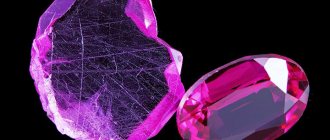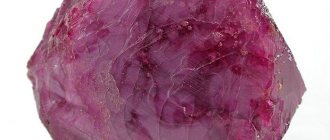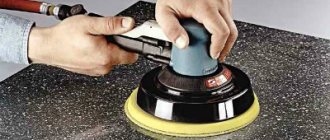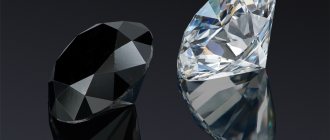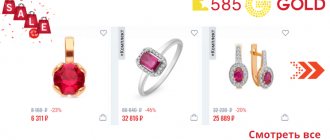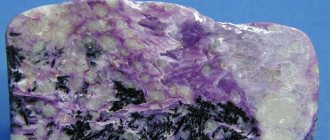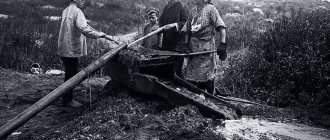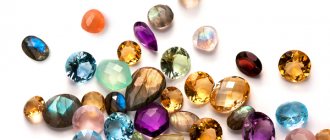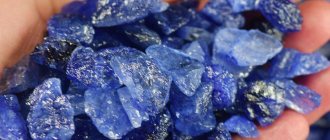Corundum
- mineral, crystalline α-aluminum oxide (Al2O3) (crystalline alumina). The name is of ancient Indian origin (probably from the Sanskrit “kauruntaka” or Tamil “kurundam” - this is how this mineral was called in India and Ceylon; possibly from the Sanskrit “kuruvinda” - ruby). The corundum stone is well known to mineralogists, chemists, mechanical engineers, electronics engineers - in a word, to everyone except jewelers. And all because corundum is a stone whose properties for the most part have nothing to do with jewelry.
- Structure
- Properties
- Morphology
- Origin
- Application
- Classification
- Physical properties
- Optical properties
- Crystallographic properties
See also:
Corundum
– price and medicinal, magical properties
Physical properties and structure of diamond
Description of corundum
Natural corundum has a transparent structure with a metallic or glassy luster.
Corundum is a mineral with a crystalline structure of alpha aluminum oxide. It is found in nature in the form of pyramids, prisms and barrels. It is considered a gemstone of the highest category. Due to the structure of the crystal lattice, its hardness is second only to diamond and is widely used not only in jewelry, but also in optics, microelectronics and other mechanical industries.
The stone has high transparency, luxurious shine and bright color, but cloudy specimens are more common.
Origin story
Corundum has been known since the times of Ancient Egypt and Judea. Mentions of it can be found in ancient texts: it was used to decorate the robes of priests and high priests.
Corundum came to Europe from India, but the name, which has Sanskrit roots, did not take root. Precious stones, which have a common name in the East, were united in the Old World only in the 19th century.
In Russia, the stone has been known since ancient times. Under the name "yakhont" he often appeared in folk art. Researchers are sure that in Rus' this stone was mined independently, although there are hypotheses that it was brought from the East along the Silk Road.
Deposits and stone mining
Corundum forms where igneous rock comes to the surface or in underground air cavities rich in aluminum. It is formed under pressure and high temperatures over thousands of years. Most often, stones can be found in mountain ranges in the form of rare inclusions, so their extraction from the rock is impractical.
There are only a few rich deposits of corundum - terrestrial alluvial rocks. Over millions of years, the mountain range is gradually destroyed, its rock falls into rivers and is polished by water. The hardest particles - rubies, sapphires - are not destroyed and remain in the riverbed at a depth of half a meter. They are removed by washing and digging up the soil in those places where accumulations have formed.
Blue minerals are less common in nature than red ones.
This is how corundum is mined in Thailand, Sri Lanka, Burma and Tanzania. Clusters of blue minerals are more common in rocks and are periodically mined directly from the veins. For example, Kashmir dark blue sapphires are being mined in mines in the Himalayas. Less significant deposits of jewelry stones are located in Madagascar, Myanmar, Russia, Greece, Norway, Australia, Brazil, Canada and the USA.
Types of stone
Types of corundum are distinguished depending on color.
Rubies
Ruby, or red yakhont, is a type of stone with a scarlet color, which is given by impurities of chromium. Transparent rocks are more valuable than diamonds. Burmese rubies are considered the most expensive. They have a rich, deep scarlet hue with a bluish tint - the color of pigeon's blood. Thai stones are distinguished by a light brownish tone - Siamese. Rubies from Sri Lanka are scarlet with a bright crimson tint, and Vietnamese ones are purple.
There is a special type of red yacht with an asterism effect. In another way, this mineral is called star ruby. When light hits the stone, it creates the effect of a star shining inside.
The category of rubies includes primarily stones of a bright red hue.
Sapphires
Sapphire, or azure yakhont, is a precious blue or light blue corundum, colored with titanium atoms. The richest cornflower blue stones from India - Kashmiri - are considered the most valuable. Siamese minerals from Thailand have a greenish tint. Sapphires from Sri Lanka (Ceylon) are light blue with a bluish tint.
In Tanzania, unique stones are mined that change their color depending on the lighting (the so-called alexandrite effect). Shining asterias (star sapphires) and minerals with a cat's eye effect are especially valued by jewelers.
Sapphire is a precious stone that is cheaper than ruby.
Other types
In addition to the familiar rubies and sapphires, there are other types of corundum:
- Padparadscha , which is translated from Sinhala as “lotus color”, is a stone that has an orange-pink color. The iridescence of its shades is poetically called “the color of the sunset tropical sky” or “molten gold.” But this species is valued not only because of its color. Compared to ruby, the mineral is more transparent and has fewer defects. It is believed that real padparadscha is found only in Sri Lanka.
- Green corundums are oriental emeralds, or chlorosapphires, less valuable stones of deep color, sometimes with a yellowish tint.
- Violet - oriental amethysts, iridescent in shades from pink to dark lilac.
- Polychrome sapphires are rare yellow-green, violet-blue or, for example, blue-green corundum. In the structure of the stone, 2 dissimilar colors are visible, which is due to impurities in the rock.
- Leucosapphires , or oriental diamonds, are the rarest varieties. Transparent, with a metallic or glassy sheen, without any color. They are especially highly valued among jewelers because of their uniqueness.
- Emery , or technical muddy corundum, has no jewelry value. Due to its hardness it is used as an abrasive. It can be either white or brown. The first one is looser, but at the same time it is a pure abrasive - it contains 99% Al2O3.
In nature, not only blue and red, but also other varieties of corundum are found.
Sapphires
Sapphire corundum is valued lower than its red counterpart, but still quite highly valued. Its beauty has attracted people since ancient times. Mages and priests used the crystal in their mysterious rituals. The shades of such a gem can be very different. It can be a bright, heavenly color, or a faint, pale blue. The highest price is for minerals with a shade that is medium in saturation but deep in tone.
Let's consider what types of such sapphires there are.
- Oriental amethysts are gems colored in all shades of purple. They have nothing in common with amethysts except the name.
- Chlorosapphire. It is highly valued due to its rarity. The color scheme of this gem is bright green. It is sometimes difficult to distinguish such a stone from an emerald. They are often obtained artificially by irradiating ordinary corundum under an X-ray lamp.
- Padparadscha is a warm pink, reddish, orange or yellow mineral. They come in both dark and light, and transparency also varies.
- Leucosapphires. Pure corundums, impeccably transparent, like pure diamonds. This similarity is due to their ancient name - oriental diamonds.
- Star sapphire. Extremely rare specimens that resemble star rubies - primarily due to the asterism effect. Pure crystals with geometrically precise patterns of edges stand incredibly high. Such specimens quickly disperse into elite private collections.
Areas of application
Corundum is a mineral that is widely used in various industries - from making jewelry to making microcircuits.
Jewelry
Precious transparent rocks are valued by jewelers from all countries. Rubies and sapphires are cut to increase dispersion and light refraction. Most often, white, yellow or red gold is chosen as a setting for natural gems.
Corundums are suitable for making any types of jewelry: pendants, earrings, necklaces, rings. Products with rubies and sapphires always look luxurious and attract admiring glances.
In addition, boxes, bracelets, watches and other luxury items are inlaid with stones.
Other areas
The areas of application of corundum are different:
- Collecting - corundums, unique in their structure, color or size, become the crown of a collection of precious minerals.
- Processing of materials - until the twentieth century. cloudy gem samples were used as abrasives: for grinding, processing and cutting. Now artificial stone is grown for these purposes.
- Sound recording - synthetic corundum is used to cut lamellas on vinyl records.
- Technical area - stones are used as bearings in high-precision and complex computing mechanisms: watches, scales, etc.
- Laser production - ruby rods are used in pointers, in scanners for reading barcodes, for cutting and welding, as well as for creating profile optical devices.
- Glassmaking - high-strength sapphire crystals are made for watches, telephones, airplane windows and even spaceships.
physical characteristics
Corundum is a stone from the category of ornamental and precious minerals. Their origin is associated with crystallized alumina. The mineral is characterized by high strength. According to this indicator, it is inferior exclusively to diamonds. Such minerals differ in shades and degrees of transparency. After processing, it is possible to obtain ruby corundums and sapphires.
Real stones are present in the rock in the form of small inclusions, grains or large clusters. The top of the mineral is covered with an unattractive coating. It has a gray color. The chipped areas show the true color.
Nuggets are rarely saturated in color. In most cases, they are distinguished by a faded shade. Today, jewelers know how to thicken and lighten the colors of stones through calcination, heating, and irradiation. This does not affect their physical and chemical properties, and also does not affect their healing and magical characteristics.
Corundum stone can be natural or artificial. The grown crystals are characterized by an affordable price and ideal shade. They are not characterized by the presence of internal cracks or other defects. Synthetic corundum is made from glass or artificial material.
The basis of the natural mineral is considered to be α-aluminum oxide – Al2O3. This is a pure and transparent leucosapphire formula. The structure of other types of corundum may contain chromium, iron, titanium, and manganese. The content of impurities affects the saturation of the shade.
The physical properties of the corundum mineral include the following:
- density – up to 4.1 g/cm3;
- uneven break line;
- melting point – 2050 degrees;
- trigonal similarity;
- hardness – 9 points in accordance with the Mohs scale.
Corundum crystals can look like a barrel, a plate or a double pyramid. The lattice of the mineral consists of rhombuses with identical edges that are in close contact with nearby sides.
Physicochemical characteristics
The main properties by which corundum is distinguished from other minerals:
- strength on the Mohs scale - from 8.5 points;
- density per 1 cm³ - about 4 g;
- trigonal system and lack of cleavage - high purity;
- crystal structure - when a ray of light is directed at a stone, it is refracted into many rays;
- glass diamond luster;
- resistance to high temperatures - melts at +2050 ⁰С;
- resistance to chemical and mechanical influences.
Diagnostic signs
It differs from similar minerals in its high hardness, crystal shape, and shading on the edges. It differs from kyanite in the absence of cleavage and hardness; ruby - from red spinel in crystal form or under a microscope.
Associated minerals. Potassium feldspar, acid plagioclase, biotite, muscovite, garnet, andalusite, dumortierite, quartz, diaspore, hematite, rutile, spinel, magnetite, ilmenite, sillimanite, chlorites, calcite, dolomite, pyrite.
Corundum. Crystals in syenite
Healing properties
In lithotherapy, corundum is credited with many medicinal properties depending on its color. Thus, rubies have a beneficial effect on the cardiovascular system and everything related to blood circulation. Sapphires are good for vision and women's health. Orange gems improve the functioning of the gastrointestinal tract and increase the overall tone of the body. Green - protect against colds and infectious diseases, increase immunity.
Lithotherapists believe that corundum stone has healing properties.
Therapeutic effect
The mineral is used in the treatment of:
- eye;
- pressure;
- vessels;
- hearts;
- female reproductive system;
- metabolism.
Rubies are useful for paralysis, sapphires for high eye pressure. Purple stones improve the functioning of the nervous system and enhance memory.
White and gray specimens relieve muscle tension, green ones activate the immune system, orange ones rejuvenate.
Corundum is a valuable healing mineral
Lithotherapists recommend corundum to patients:
- schizophrenia;
- sleep disorders;
- osteochondrosis;
- overweight;
- neuralgia.
Magic properties
Since the times of the Ancient World, corundum has been considered a magical stone and a powerful amulet, the importance of which is difficult to overestimate. Its active influence is also noted by modern healers. With the help of sapphires and rubies they cast love spells.
For example, a ritual with sapphire can strengthen existing relationships and attract the attention of a partner.
On Friday, at dawn, in the first hour after sunset, you should draw a circle clockwise and place 5 candles in the shape of a star with the beam up. Place a red rose next to each candle so that they are located inside the circle. In the center you need to place a photo of your lover, put a sapphire on it and say the spell:
Magic love spell words.
Are common
Wearing jewelry with this stone promotes the development of creative energy and spiritual growth of the owner. Pendants and pendants are recommended for people suffering from anxiety and depressive disorders. The active energy of the stone helps purposeful and bright individuals achieve their goals.
Abilities depending on color
It is believed that each corundum has special properties depending on its color:
- Red ruby represents passion and libido, helps in romantic relationships and strengthens family bonds.
- Blue and light blue sapphire promotes self-determination and the discovery of talents, helps to concentrate and gain self-confidence.
- Purple stone brings luck and success.
- Yellow or orange corundum promotes energy, activity and determination in any activity.
How to wear jewelry
Externally, artificial and natural inserts of accessories are indistinguishable, so the wearing rules are similar:
- corundum is combined with gems of equal level: jewelry with malachite, turquoise, jasper, coral or other similar ones - bad manners;
- the younger the owner, the lighter and smaller the inserts; pink or sky blue is suitable for a teenage girl or young girl; regal purple and deep blue - for a mature lady;
- if you want to show off a stone, choose a modest frame, preferably silver;
- appropriate wardrobe: branded or custom-made.
Colorful colors, a tracksuit or cheap fabric will blur the impression of the decoration.
Who is corundum suitable for?
Corundum is a stone with powerful and active energy. It suits purposeful, dynamic and powerful people who are not used to sitting still.
Zodiac sign
Astrologers believe that corundum is suitable for people born under the sign of Cancer. Those with a Capricorn or Aries horoscope should avoid these stones due to the incompatibility of energies.
Rubies are recommended to be worn by Leos and Scorpios: the powerful energy of these people coincides with the impulses of the stone. Such a tandem can conquer any heights.
Sapphire is more suitable for people born under the sign of Aquarius, Taurus or Sagittarius. Blue corundum will help them unleash their creativity, gain self-confidence and develop talent.
By color type
Blue and cyan sapphires are suitable for cold “summer” and “winter” color types. Winter hot brunettes with porcelain skin should choose darker shades of stone or pay attention to rubies the color of pigeon blood. Summer fair-haired beauties should wear jewelry with Ceylon or Kashmir sapphire - the minerals will favorably highlight the color of the eyes and give freshness to the face.
The warm color types “autumn” and “spring” correspond to rubies. The chestnut-chocolate palette of autumn girls is perfectly emphasized by deep and rich scarlet stones. For spring wheat blondes with peachy skin, we can recommend jewelry with pink-orange padparadscha.
Corundum and zodiac sign
Corundum does not have a beneficial effect on all zodiac signs. His favorites are Cancer, Aquarius and Pisces, whom he helps and guides in the right direction. Corundum is highly not recommended for Aries and Capricorn men, as it has a negative effect on them. Only mature Aries women can wear jewelry with corundum without fear of the negative effects of the mineral.
How to distinguish a real stone from a fake
Corundum counterfeiting is a profitable business. Masters have learned to create specimens that are almost indistinguishable from a real mineral. Therefore, before purchasing, evaluate the stone not only from the photo, but also in person.
Natural corundum is never uniform in color - upon closer inspection it is easy to see the alternation of light and dark shades.
It is impossible to find a gem in nature without visual defects and small chips - they will be visible under a magnifying glass.
Another way to test corundum is to illuminate it with an ultraviolet lamp. Natural ruby luminesces with red light, blue sapphire with violet, and orange with yellow. If the glow color is green, this is a fake.
The easiest way is to ask the seller for a certificate for the gemstone or take the mineral to a jewelry workshop for examination.
Synthetics
Artificial minerals often contain air bubbles that can be seen under magnification. In natural stone, the presence of gas bubbles is also allowed. The difference is that they are always of the correct spherical shape and are present in small quantities. Another way to identify synthetics is to throw a stone into the water. Thanks to air bubbles, artificial corundum will rise to the surface or float in the water column, while natural corundum will instantly sink to the bottom.
Ennoblement
Refining is the process of improving the quality of stone by heating, polishing and restoration. Therefore, it is easy to distinguish a fake with the help of a magnifying glass. Inside the restored stone there will definitely be specks or other foreign inclusions.
Glass
To distinguish real corundum from glass, it is enough to run a sharp metal object over the product. There will definitely be a scratch on the fake, while the natural stone will not be damaged.
Caring for stone products?
You can preserve your favorite jewelry with a stone if you follow certain rules when caring for it:
- Keep the gemstone in a separate box with velvet sides and a soft bottom.
- Don't leave it in bright light for too long, especially in the sun.
- Do not allow the crystal to overheat. This can lead to a change in the original color of the stone to lighter shades.
- If your jewelry becomes dirty, do not use soap compositions with dyes or aggressive additives that may harm the product.
- Do not use hard or scratchy objects to clean it.
Artificial corundum
Synthetic corundum is produced in Switzerland, Germany and Russia. It is grown for industry: abrasive tools, ruby rods and optics. However, many artificial minerals are found in cheap jewelry.
Since natural crystal is very expensive, artificial corundum is in great demand.
Synthetic corundum is obtained from alumina by crystallization.
Interesting Facts
It's amazing how big corundums can be in nature:
- The "King of Gems" is the world's largest ruby. Its weight is 2475 carats. It was found in Yugoslavia and is now owned by a private individual.
- The British Natural History Museum houses the Edwardian Ruby, the most famous cut ruby. Its weight is 167 carats.
- The Dutch jewelry house owns the pale blue “Blue Princess” sapphire. It is recognized as the most perfect in terms of aesthetic parameters and weighs 114 carats.
- The Diamond Fund in Moscow houses a Ceylon sapphire of cornflower blue color with a violet tint. Its weight is 260 carats. The stone is set in an openwork gold brooch and surrounded by diamonds.
In addition, corundum is an excellent heat insulator. A millimeter layer of gem can replace 5 cm of mineral wool.
https://youtube.com/watch?v=waJPymFMR2A%3Fstart%3D409
